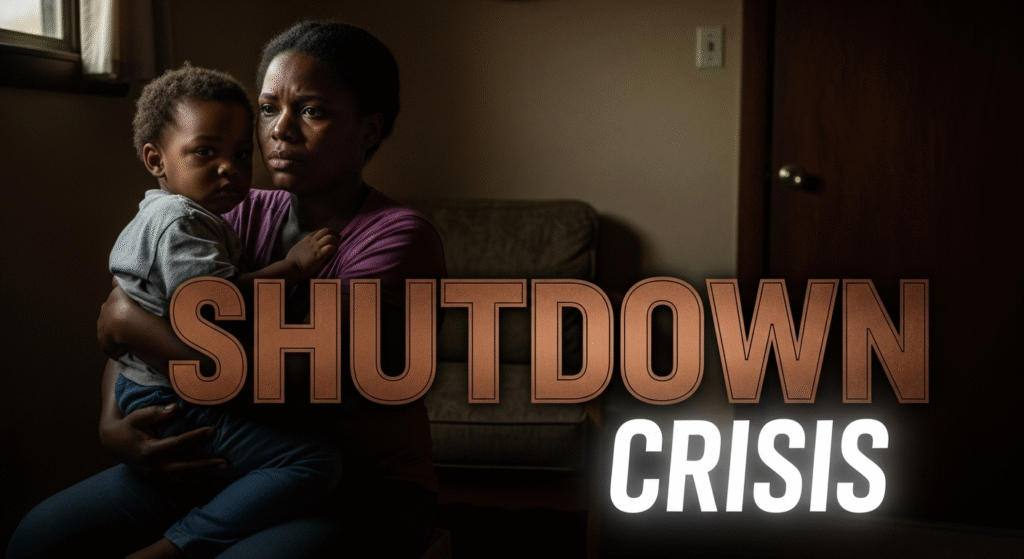

2025 Government Shutdown: History Behind the Headlines
By Darius Spearman (africanelements)
Support African Elements at patreon.com/africanelements and hear recent news in a single playlist. Additionally, you can gain early access to ad-free video content.
On November 12, 2025, President Donald Trump signed a bill that officially ended the longest government shutdown in United States history. The 43-day standoff caused massive disruptions nationwide, but the headlines only scratch the surface. This political deadlock was not just a fight between politicians in Washington D.C. It was a crisis that sent shockwaves through our communities, hitting Black families, federal workers, and small businesses the hardest. To truly understand the impact, we must look at the history that set the stage for this moment and unpack the specific ways this shutdown targeted the lifelines of Black America.
The shutdown began on October 1, 2025, when Congress could not agree on funding for the 2026 fiscal year. The main disagreement was over healthcare. House Republicans wanted to pass a spending bill without extending the Affordable Care Act (ACA) premium tax credits, which help millions of people afford health insurance. Senate Democrats refused, arguing that letting these subsidies expire would be devastating. This stalemate left the government without money to operate, forcing a shutdown that would break all previous records and expose deep vulnerabilities within our communities.
A History of Political Standoffs
The idea of a government shutdown is actually a modern problem. It stems from the Antideficiency Act, a law from 1884 that prevents the government from spending money it does not have (wikipedia.org). For many years, agencies would continue working during funding gaps, expecting the money would come eventually. However, in the 1980s, new legal opinions from Attorney General Benjamin Civiletti established that agencies had to stop all non-essential work when funding lapsed. This interpretation created the shutdowns we know today.
Since 1980, the U.S. has had 11 shutdowns that resulted in federal employees being sent home without pay. The 1995-1996 shutdown under President Bill Clinton lasted 21 days and was the longest at the time. In 2013, a 16-day shutdown occurred over funding for the Affordable Care Act during the Obama administration. More recently, the 2018-2019 partial shutdown under President Trump lasted 35 days, setting a new record over a dispute about border wall funding (wikipedia.org). Each of these events shows a pattern of using the government’s basic functions as a bargaining chip in political fights. Consequently, the 2025 shutdown was not an isolated incident but the latest chapter in a long story of partisan conflict.
Duration of Major U.S. Government Shutdowns
This chart shows the increasing duration of major shutdowns, culminating in the record-breaking 43-day shutdown in 2025 (wikipedia.org).
The Hidden Costs to Our Health and Well-Being
The 2025 shutdown was centered on a debate that directly affects the health of Black families. The fight over ACA subsidies and proposed cuts to Medicaid was not just about numbers on a spreadsheet; it was about access to healthcare in a community that already faces massive health disparities. African Americans disproportionately rely on both Medicaid and subsidized ACA plans for health coverage. Losing these supports would have been catastrophic, leading to higher uninsured rates and reduced access to care for everything from preventative screenings to managing chronic illnesses like diabetes and heart disease.
This threat to healthcare access would only worsen existing racial health gaps in areas like maternal mortality and life expectancy. The shutdown therefore became a direct threat to health equity in our communities. A breakthrough finally occurred on November 9, when a bipartisan group in the Senate negotiated a deal. The agreement, which passed the House and was signed by President Trump on November 12, funds the government through January 30, 2026. However, it pushes the debate on ACA subsidies to mid-December, leaving the future of our healthcare uncertain (bipartisanpolicy.org). The temporary solution merely postpones a critical decision.
When Paychecks Stop: Black Federal Workers on the Brink
During the shutdown, roughly 900,000 federal employees were furloughed, and another two million had to work without pay. This hardship was not felt equally across all demographics. African Americans are overrepresented in the federal workforce compared to our share of the total U.S. population, which means we were more likely to be directly impacted when the paychecks stopped coming. This is not just a statistic; it represents hundreds of thousands of Black families facing immediate financial crisis.
For many of these families, a missed paycheck is not an inconvenience—it is a disaster. A disproportionate number of Black federal workers hold lower-paying positions and live paycheck to paycheck. Suddenly, they could not cover essential expenses like rent, mortgages, car payments, or childcare (govexec.com). Even though federal employees typically receive back pay after a shutdown ends, the damage is already done. Families are forced to take on debt, drain their savings, and damage their credit scores. The economic burden, as a result, extends long after the government reopens, creating lasting financial instability.
Black Representation in the U.S. Workforce
This chart illustrates how African Americans are overrepresented in the federal workforce, making them more vulnerable to shutdowns (ourpublicservice.org).
The Ripple Effect on Essential Services
Beyond the paychecks, the shutdown halted or delayed critical programs that our communities depend on. Head Start, a program that provides early learning, nutrition, and health services, was hit hard. African American children make up a substantial portion of Head Start enrollment (nhsa.org). On November 1, many Head Start programs in over 40 states missed their scheduled federal funding. This led to temporary closures, leaving thousands of children without vital care and meals. For low-income families, these interruptions created immense financial and logistical burdens, and the disruption to a child’s development can worsen existing educational disparities.
Similarly, delays in the Supplemental Nutrition Assistance Program (SNAP) had severe consequences. Black households experience higher rates of food insecurity and rely heavily on SNAP to put food on the table. When those payments are interrupted, families are forced to skip meals, buy cheaper and less healthy food, or go into debt just to eat. The stress and uncertainty of not knowing where the next meal will come from takes a heavy toll on the mental and physical health of both parents and children. Thus, the shutdown created a cascade of crises, from education to nutrition.
Economic Shockwaves in Black Neighborhoods
The shutdown cost the U.S. economy an estimated $11 billion in permanently lost growth, but that massive number does not tell the whole story. The economic damage was especially severe for Black-owned businesses and communities. Many Black entrepreneurs rely on federal contracts, loans, and grants to operate and grow. During a shutdown, payments for existing contracts are delayed, and new loans from agencies like the Small Business Administration are not processed (hklaw.com). Black-owned businesses often have fewer cash reserves and less access to credit, making them far more vulnerable to these disruptions.
In addition to that, community organizations and social justice groups that serve Black communities also suffered. Many of these programs depend on federal grants to fund their work. When grant processing freezes, their ability to provide critical services is jeopardized, forcing them to scale back programs or even lay off staff. In neighborhoods with a high concentration of federal workers, local businesses saw a sharp decline in spending, creating a ripple effect of economic instability. The shutdown, therefore, was not a distant political battle but an economic assault on the foundations of our communities.
Economic Cost of Recent Shutdowns
Permanently Lost U.S. GDP
Both the 2018-2019 and 2025 shutdowns were estimated to have cost the U.S. economy $11 billion in lost productivity (pgpf.org).
An Uneasy Truce and an Uncertain Future
The bill signed by President Trump provides immediate relief by reopening the government, but it is not a permanent solution. It is a temporary patch that funds most agencies only through January 30, 2026. Crucially, the core issue that triggered the crisis—the extension of ACA subsidies—has been deferred until mid-December. This means that another political showdown is right around the corner, leaving millions of families, including a disproportionate number of African Americans, in a state of prolonged uncertainty about their healthcare.
This shutdown has once again shown how political games in Washington have real and devastating consequences for our communities. While the immediate crisis is over, the threat remains. The pattern of using government funding as a weapon in policy debates continues, and the people who suffer most are often those with the fewest resources to withstand the blow. Looking ahead, the fight for stable government funding is also a fight for the health, financial security, and well-being of Black America.
About the Author
Darius Spearman is a professor of Black Studies at San Diego City College, where he has been teaching for over 20 years. He is the founder of African Elements, a media platform dedicated to providing educational resources on the history and culture of the African diaspora. Through his work, Spearman aims to empower and educate by bringing historical context to contemporary issues affecting the Black community.
